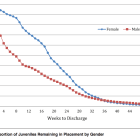
To Help Youth with Trauma Brain, Treat Entire Family
|
Can we treat, heal and prevent reoffending in a youth if we have not treated and healed the primary parent of the youth?
Juvenile Justice Information Exchange (https://jjie.org/tag/childhood-trauma/)

Can we treat, heal and prevent reoffending in a youth if we have not treated and healed the primary parent of the youth?

When officials in four states were asked several years ago what tools they would need to divert youth from the juvenile justice system, a better understanding of trauma was at the top of all their lists.
Juvenile justice reformers risk leaving girls behind if they fail to consider how traumatic experiences push girls into the system, says a new report.
Many services for children and families in Connecticut incorporate trauma-informed care, but more needs to be done to improve outcomes for children, according to a new report from the Child Health and Development Institute of Connecticut.

Girls are more likely to be arrested for less serious offenses but are more likely to have serious problems, including a history of physical and sexual abuse.

Girls serve longer sentences than boys in the Texas juvenile justice system, and for less serious offenses, according to a new study from the University of Texas at Austin.

WASHINGTON, D.C. - Two out of three children in the United States experience or witness violence, crime or abuse while growing up, a public health crisis that harms their emotional, physical and intellectual development and makes them more likely to perpetrate the same trauma upon their own children, a national task force appointed by U.S. Attorney General Eric Holder said this week. The long-term well-being of the country is at stake unless federal and local governments and their communities act to reduce the incidence and impact of such trauma upon young Americans, the National Task Force on Children Exposed to Violence concluded in its final report. The report detailed 56 policy recommendations for reducing such exposure to trauma and treating its fallout. Such exposure could occur anywhere, the report said: at home, at school, in the community and on the Internet. “There is a moral component to this question,” Holder said at a public meeting of the federal interagency Coordinating Council for Juvenile Justice and Delinquency Prevention, which approved the report’s release.

The majority of American youth behind bars have suffered trauma during their childhoods, a newly released report by the Justice Policy Institute (JPI) says. According to Healing Invisible Wounds: Why Investing in Trauma-Informed Care for Children Makes Sense, of the more than 93,000 children currently incarcerated, between 75 and 93 percent have experienced at least one traumatic experience, including sexual abuse, war, community violence, neglect and maltreatment. “Incarcerated youth already face significant challenges, but youth who have experienced trauma are even more acutely affected,” says author Dr. Erica Adams. The brief, published by the Washington, D.C.-based organization that promotes the reduction of the nation’s prison population, notes that youth who engage in delinquent behavior should be held accountable but also strongly suggests that judges consider trauma exposure when deciding where youth are placed. Young people who receive treatment in the community tend to have better outcomes than those placed in correctional facilities, the report says. “We simply cannot afford to ignore the evidence and prevalence of the long-term effects of untreated childhood trauma,” says JPI Executive Director Tracy Velázquez.